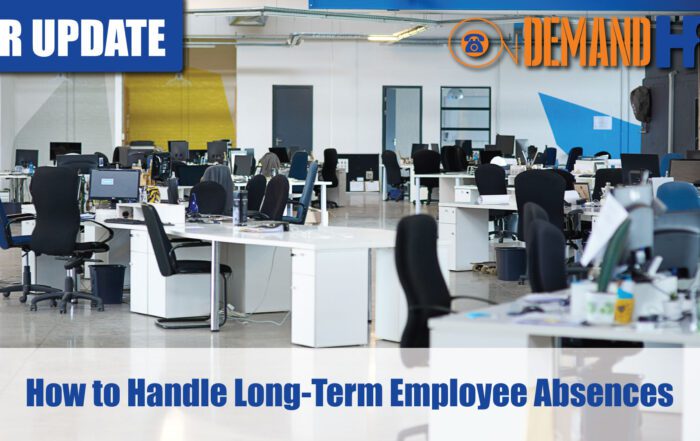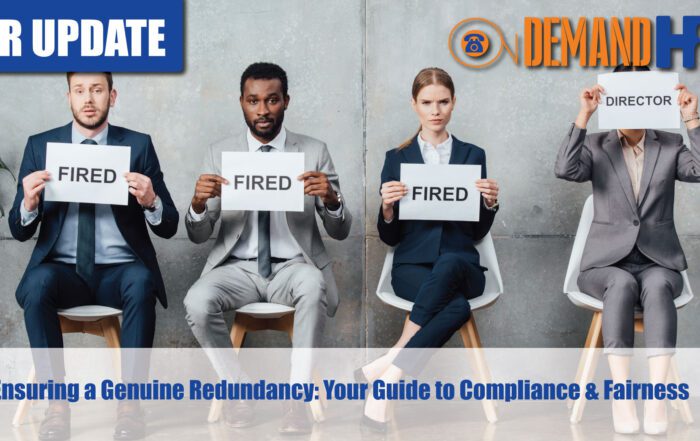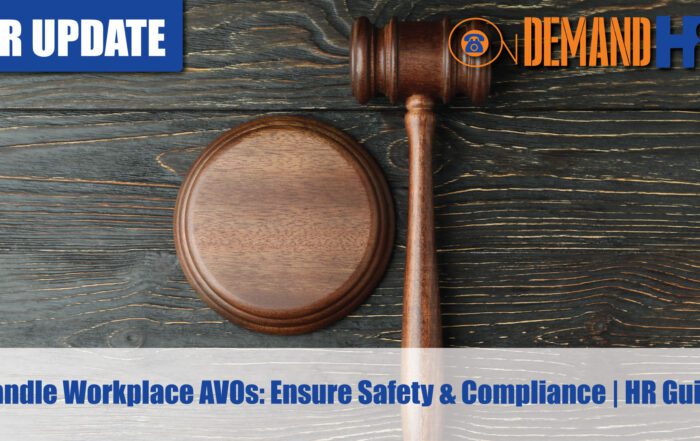Redundancy – Alternative Jobs & Selection Criteria
If you are carrying out a redundancy process, you are required to consider alternative positions and if multiple roles are impacted have a robust selection criteria. But what does that really mean? How do you protect yourself from unfair dismissal?
Please see below for a full transcript of the video.
Share the HR or workplace relations challenge facing your business and one of our experienced consultants will be in touch within 24 hours with a strategic action plan or discover the best strategy yourself by accessing out free online training library.
Transcript
0:00
I’m going to move on now to alternative jobs and selection criteria. And, again, as I mentioned during the presentation, it’s very important to think about any possible vacant roles in the consultation process, even if the role is significantly different in location, pay up or down, status, whether it’s, you know, a casual role, and the person is full time, duties, whether the duties are significantly different from the role to be made redundant. And the most important reason you’re doing this is to manage the risk is so that there can’t be an argument that there was a vacant role there that wasn’t offered to the employee.
And look, I actually had a great example of this with a client last year, a redundancy process we worked on for them. So they had a it’s basically a company in the IT space, I can’t be specific about what the company does, but they had a role. There had two sales roles, based in Victoria and based in Queensland, and they were looking to make both of these roles redundant. And they basically said, Look, we want to get out of the roles in VIC and in Queensland, we want to actually put the resources into the United States. And I said, Well, is there going to be sales roles created in the United States as a result of this particular change? And they said, Yes. And so what we actually did as part of the restructuring process, knowing that there was a 99% chance that these employees were going to reject that offer of alternative employment, we said, Look, your roles in Victoria and Queensland will be made redundant, or they’ve they’re at risk of being made redundant. However, we have these roles available in North Carolina, that will be there should you wish to apply for them. And, you know, no surprises that neither of these employees wanted to up end their whole life and move to the United States for these jobs.
But what that demonstrated was that the company thought carefully about the matter, thought about the vacant roles that were available, you know, considered section 389, and whether there were alternative roles, and even though they’re operating in a different Workplace Relations system, it was still important to put that role forward as a means of mitigating the risk. And yet again, it was a very successful redundancy process that went through without a hitch. So, again, that was something that even though we knew that those employees were 99% sure, we’re not going to take those roles. Important to put forward.
I’ve had other ones where we’ve had, you know, general managers on or not general managers, but let’s say, you know, people on in $100,000 roles being offered a casual warehouse role for, you know, 25 bucks an hour. So, again, even though those roles are completely different, and again, 99% chance that they’re not going to take it, it’s important to consider any vacant roles that you may have in the organization.
If you look at the if you look at the matter I dealt with those 10 years ago, in the commission with Specialty Fashion Group, one area that they failed, in particular in the decision, if you look at it is that around that they had vacant roles, and they didn’t offer them to the people that were being made redundant. So that was how we were able to advance the interests of our clients in that particular manner. So consider any of those alternative roles, and always good to kick around ideas on those particular matters before undertaking the consultation process.
So selection criteria is another thing I’d like to just dive into a little bit further today. So selection criteria relates to the in circumstances where a position is to be made redundant, if it’s one of a number of similar roles. An objective selection criteria is important to demonstrate fairness. And for the purposes of this discussion, I’m going to use accountants because we’ve got a lot of accountants on the line today, haven’t seen a lot of accounting redundancies in the last 12 months. That’s probably great news for the accounting fraternity that your jobs are probably as secure as they’ve ever been. But let’s say hypothetically, I’ve got, you know, five tax accountants in my firm, I need to reduce by two. So then what I would do going into a redundancy process is I can’t just simply say, okay, I’ve picked this person or this person, and that’s it, and then just go ahead with the redundancy.
What I really need to do if those roles are all similar or the same, I need to have some sort of science behind why I’ve picked these two people from the batch of five, okay. And things that you might look at might include, okay, skills, experience, performance, qualifications, the breadth of duty, so I might look at let’s let’s take a accounting example for that, you know, for the purposes of this discussion, so can my can this tax accountant do smsfs? Can this tax accountant Do you know, monthly can they do? Can they do quarterly BAS’s? Can they do Can they consult with a client at the end of the year about their tax affairs? Can they give advice on ATO matters? Can they you know, seek payment extensions, things like that, can they, you know, give advice on ASIC matters?
So, you might have a whole bunch of these criterias that you might have for your five accountants and then sort of you can either go a kind of a, an out of 10 score on each of these five criteria or three criteria doesn’t have to be overly complex. And what you’ll find is you’ll end up with the same result anyway, is that the people in your head that you thought, Oh, well, they were the, they’re the two weakest links, and those are the ones that should go, that will actually play out in the criteria anyway, because, you know, most people in business will make the right operational decisions based on what they think is best talent for them to retain going forward.
Look the other way you can approach redundancies, you can approach them on a voluntary basis before going through forced redundancies. I’m not a big fan of voluntary redundancies, because what I find happens in voluntary redundancies is that let’s say for example, you’ve got 10 accountants you want to offer to redundancies the people that are probably most likely to put their hand up to take the redundancies are probably your best people, they’re probably the ones that will take it because they go well, you know what, I can get this, I can get this, this wad of cash, and then go off and find another accounting role tomorrow like that. So not a big fan of voluntary redundancy processes. I’m open to them in circumstances where the jobs are basic and and there’s not much difference between Person A and Person B. But you know, let’s just use the tax accountant situation and there is a big difference between a good tax accountant and a bad tax accountant or not so good tax accountant should I say? So, again, think about that. And most of the time, I prefer what I would call a forced redundancy rather than a voluntary because you’ll you’ll end up retaining the best talent after the restructure has taken place. There’s no point you know, if you’re going to do you know five employees and make two redundant, there’s no point keeping you’re keeping your worst three, you want to keep your best three. So that’s, that’s how you’d approach it.
The other thing I would say is that you need to really consider that selection criteria before restructuring commences and it doesn’t have to take very long, we can give you advice on you know what sort of criteria you might consider how you might score it, you’ll end up with probably the same result you’ve had anyway, in your head. It’s just putting it out in bringing into some science on how the people were selected.
We have put together this what we call limited time restructure package for anyone who’s looking at undertaking a restructure, and that is and that would offer the following services as part of the restructure package that we will provide you with the restructuring and redundancy plan. We provide you with advice on the payments and the related obligations. We give you the initial meeting plan the initial consultation letter, we would give you advice about the alternative jobs and selection criteria if it’s applicable, we give you advice on the further consultation discussions, the final meeting plan, the final meeting and the discussions and letters around those things. We can organize for you outplacement and EAP. And we can give you a discount for the Fair Work Commission proceedings should you need us to represent you should any matters go before the commission for any for any clients with 1-3 redundancies or one to three employees in that restructure costs $1500 plus GST. It’s a limited time offer that we’re offering only for the purposes of this because we come to the end of job keeper. We don’t normally offer this as a one off service. We do have it included in all of our support packages for clients which are essential support performance and risk and HR managers for any clients are interested in ongoing support arrangements. They are included at free of charge as part of those support packages. So if anyone’s interested in those things, please get in touch with this at ondemandhr.com.au and we can talk you through either a limited time restructuring service are all assisting you on an ongoing basis with this being at no extra cost for you as part of a monthly support.






